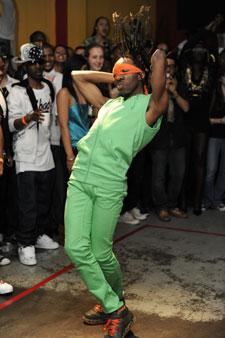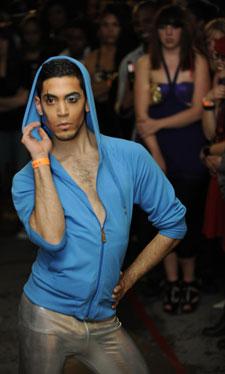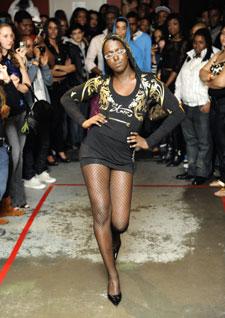
FIERCE FACTOR. Mother TKO Monroe of House of Monroe struts his stuff at PlayPen on Mar 14 at the Concord Café. Credit: Dominic Chan

BLUE ENVY. One of the competitors in the "virgin vogue" category of the voguing competition at PlayPen on Mar 14. Credit: Dominic Chan
About 250 people crowded Bloor West’s Concord Café on Mar 14 to celebrate PlayPen, Canada’s first full-on voguing ball.
Several “houses” — the scene families that voguers belong to — participated in playful competition with trophies handed out to winners for their fierce walks in various categories like “realness,” “runway” and “virgin vogue.”
“[The event] is a milestone to Toronto’s queer and trans community,” says ball coorganizer Ahmed Ahmed, who is also a coordinator of Not Pink, a group for queer people of colour in north Toronto run by the Griffin Centre. “It brought together young people who organized and built communities for themselves with organizations to seek to support them and deliver an unforgettable experience. Young people have a chance to see themselves reflected in the spaces they attend and also to take leadership in the determining of those spaces.”
In the past there have been a few similar events in Canada but there is more to a voguing ball than voguing itself. The dances and performances are an integral part of the US-originated ball scene but it’s also a place where chosen families meet to celebrate and to support community development; usually money is raised for charity and support services are offered, including, in some cases, onsite HIV-testing.
“It’s also an opportunity for young people to express themselves and meet and network with others as well as gain information about living healthier lives,” says Ahmed.
The content of PlayPen including setting the categories, theme and music was organized by the House of Monroe — DJ Blackcat aka Charmed Monroe spun at the event — while ReachOut, Griffin Centre’s queer youth program, provided logistical support including organizing the venue, promotion and bringing in community agencies, such as the Black Coalition for AIDS Prevention, to provide sexual health information at the event. Half of the proceeds from PlayPen will go to ReachOut.
York University student Felicia Morrison, 22, attended PlayPen to support a friend who entered the voguing competition.
“It was my first taste of voguing and a real ball,” says Morrison. “I loved the battles between the voguers because of the energy they exerted when they were doing their moves, the runway competition for best walk especially the guys even in drag nailing it so accurately, and the fact that the audience was involved.
“It’s a good starting point for black queer culture because simply there isn’t a lot of events or activities for people who are queer and black and the fact that they have houses and balls, it’s good for people in this culture. It was an outlet to something new and different and that was what the ball was about.”

 Why you can trust Xtra
Why you can trust Xtra


